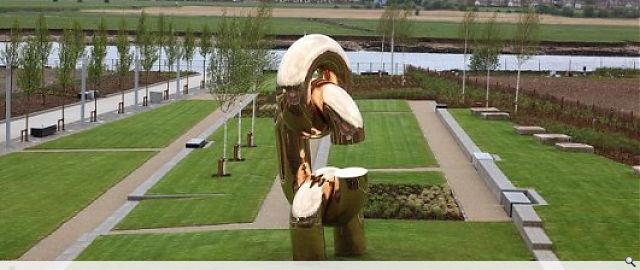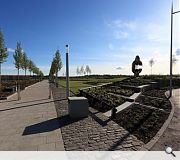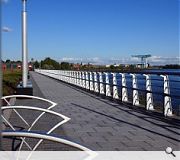Clyde Gate Park and Walkway
In addition to the development platform and infrastructure works the site includes extensive high quality public gardens and a riverside walkway. A focus of the open space is the public art, a five metre high bronze sculpture entitled “Change” which is a statement on Clydebank’s ambition for the future reflecting the long history and connection with the riverbank and shipbuilding. The sculpture stands at the apex of the gardens, overlooking Agamemnon Street and the Clyde.
The proposals made use of local and site won materials such as reclaimed sandstone, granite and granite setts. Sandstone reclaimed from the former railway abutments was used to clad the retaining wall at the site entrance. Site won granite blocks form incidental seating throughout the open green space and reclaimed granite setts from the former dock side at Queens Quay were cleaned, sorted and selected to form paving along the pedestrian walkways.
Given the site’s history as a shipyard and asbestos factory, site remediation was a significant element of the project, as was the eradication of invasive weeds, Field Horse Tail and Japanese Knotweed. Bioremediation of in-situ contaminated material was also carried out to reduce the hydro-carbon content of material for re-use on site.
The site is adjacent to the Inner Clyde Special Protection Area, a highly significant European natural heritage designation. This imposed restrictions relating to site activities and noise levels due to tidal and roosting cycles of nearby protected species.
The proposals made use of local and site won materials such as reclaimed sandstone, granite and granite setts. Sandstone reclaimed from the former railway abutments was used to clad the retaining wall at the site entrance. Site won granite blocks form incidental seating throughout the open green space and reclaimed granite setts from the former dock side at Queens Quay were cleaned, sorted and selected to form paving along the pedestrian walkways.
Given the site’s history as a shipyard and asbestos factory, site remediation was a significant element of the project, as was the eradication of invasive weeds, Field Horse Tail and Japanese Knotweed. Bioremediation of in-situ contaminated material was also carried out to reduce the hydro-carbon content of material for re-use on site.
The site is adjacent to the Inner Clyde Special Protection Area, a highly significant European natural heritage designation. This imposed restrictions relating to site activities and noise levels due to tidal and roosting cycles of nearby protected species.
PROJECT:
Clyde Gate Park and Walkway
LOCATION:
Clydebank
CLIENT:
Clydebank Re-built
ARCHITECT:
Austin-Smith:Lord
STRUCTURAL ENGINEER:
Will Rudd Davidson
SERVICES ENGINEER:
Mott MacDonald
QUANTITY SURVEYOR:
Neilson Partnership
Suppliers:
Main Contractor:
Land Engineering (Scotland) Ltd
Back to Infrastructure, Urban Design and Landscape
Browse by Category
Building Archive
- Buildings Archive 2024
- Buildings Archive 2023
- Buildings Archive 2022
- Buildings Archive 2021
- Buildings Archive 2020
- Buildings Archive 2019
- Buildings Archive 2018
- Buildings Archive 2017
- Buildings Archive 2016
- Buildings Archive 2015
- Buildings Archive 2014
- Buildings Archive 2013
- Buildings Archive 2012
- Buildings Archive 2011
- Buildings Archive 2010
- Buildings Archive 2009
- Buildings Archive 2008
- Buildings Archive 2007
- Buildings Archive 2006
Submit
Search
Features & Reports
For more information from the industry visit our Features & Reports section.





